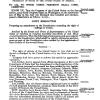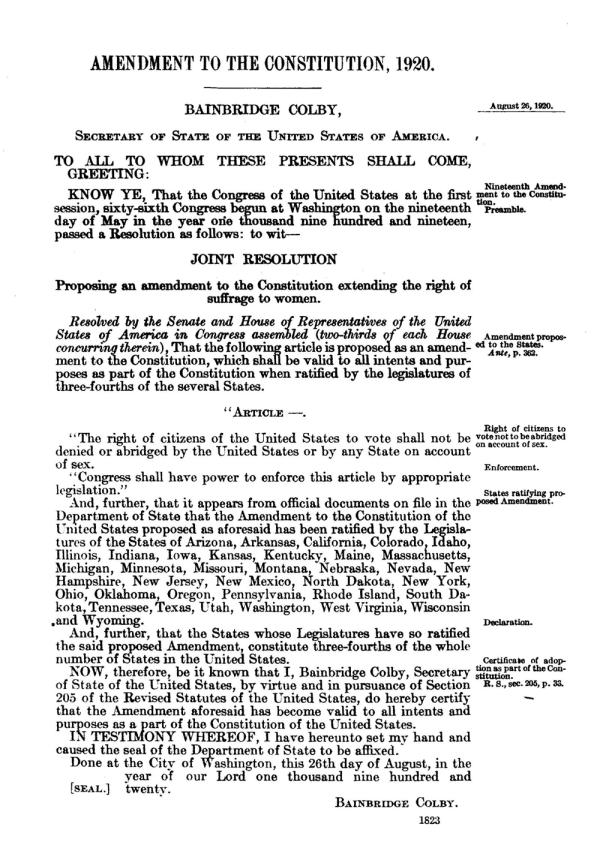Constitutional Amendment Activity
| Grade | 5th Grade | Class | Social Studies | Length of Lesson | 40-45 Minutes |
| Lesson Title | Constitutional Amendment Activity |
| Unit Title | Rights and Responsibilities: Founding Documents |
| Unit Compelling Question | Why aren't all rules good rules? |
| Historical Context: The founding documents of the United States include the Constitution, Bill of Rights, Declaration of independence, and the Federalists papers. The 1789 Constitution is the nation's oldest surviving charter of government. The 1791 Bill of Rights is a list of ten essential rights and liberties enjoyed by the citizens of the United States. The Declaration of Independence was written in 1776 and declared America's independence from the British empire. ~Allyson Simpson, Simpson College 2018.019.004 The 19th Amendment to the United States Constitution, which was adopted on August 20, 1920, gave women the right to vote by prohibiting states and the Federal Government from denying citizens the right to vote based on their sex. The 19th Amendment, which passed in 1920, came after a long struggle of women to gain their equal rights that began in the mid-1800s. In 1848, the first women's right convention was held at Seneca Falls, New York where 68 women and 32 men signed the Declaration of Sentiments. The Declaration called for laws to reflect the equality between men and women and that women too deserve unalienable rights that are guaranteed to men. This declaration began the women's movement to equality, with the first National Women's Rights Convention taking place in Massachusetts two years later in 1850. Women such as Susan B. Anthony and Elizabeth Cady Stanton formed the National Women's Suffrage Association to further promote the push for equality, with primary focus on gaining the right to vote. In 1893, Colorado became the first state to grant women the right to vote, followed by Utah and Idaho in 1896 and the state of Washington in 1910. By 1918, California, Oregon, Kansas, Arizona, Alaska, Ililnois, Nevada, Montana, New York, Michigan, South Dakota and Oklahoma all granted women the right to vote. In 1919, the amendment drafted by Susan B. Anthony in 1878 is passed by the House of Representatives and the Senate. A year later on August 26 1920, the amendment is passed as a law by Secretary of State Bainbridge Colby. |
|
| Lesson Supporting Question | |
| Lesson Overview | To begin the lesson, students will be discussing my classroom rules and whether they can change them or not in their small groups. I will bring them back together and discuss their ideas further. Next, I will show them a constitutional amendment about the women’s suffrage and also have them discuss (What is an amendment? Is this important to have in the constitution? Etc. - see below). Then I will show them a short video of how the process of an amendment being passed in congress is like. Finally, I will bring them back to my classroom rules, split them into two groups (like the house and senate) and have subgroups within the two groups come up with a new rule or a change to an existing rule and have them try to pass it through the same way an actual amendment would. Of course this part would be a bit watered down because I can’t make it too hard for them since they’re fifth graders. After this experience I’ll wrap by asking them if it was hard to pass a new amendment (rule) and why the founding fathers would want to make it hard to make an amendment to the constitution. |
| Primary Sources Used |
|
| Resources Needed | |
| Standard | |
| Lesson Target | Students will create and write their own amendments that reflect their individual rights and their awareness of having those rights to my classroom rules in five to ten minutes. |
| Lesson Themes | |
|
| Formative Assessment (How will you use the formative assessments to monitor and inform instruction?) |
I will be using an exit slip to guide how well they understood the opening processes of amending the constitution. |
| Summative Assessment (How does the lesson connect to planned summative assessment(s)?) |
This gives them close to a first hand experience of the beginning stages of amending the constitution. The supporting question is: why would the founding fathers make it so difficult to amend the constitution? This would most likely be a question on a summative assessment in the near future. Most likely a short essay or something along those lines. |
| Author | Nick Squires | Created | Last Edited | ||||
| Reviewer: Dr. Chad Timm, Simpson College | |||||||
| Lesson Plan Development Notes: Social Studies Methods, Simpson College, Spring 2019 | |||||||


